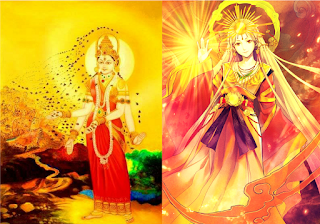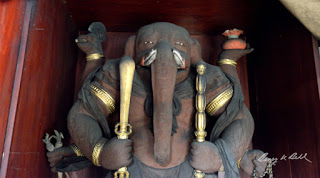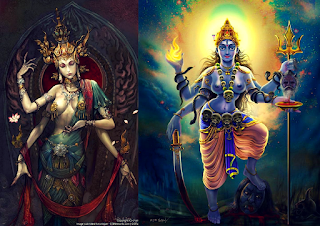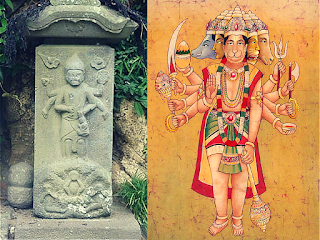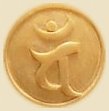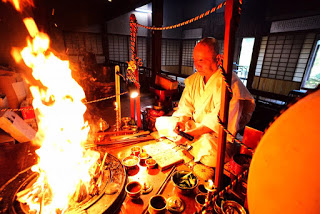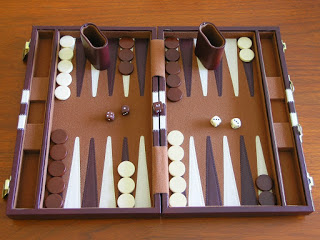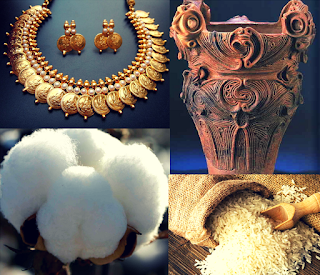Originally posted on Sanatan Dharma Blog
Almost 80 percent of Japan’s population practices Shintoism and Japan’s official Hindu population is negligible, But still there are many indications enough to conclude that the Japanese culture is product of Veidic culture. Around 5000 years Veidic culture was expanded all over the world and the world was ruled by the king of Hastinapura or new Dehli. The veidic culture is the root and basis of all the philosophies which analyse the origin of existence. It is the highest known authority and scientific theology to understand life and forms of conciousness. There was one flag of Bharata, only one culture of Bharata, one nation called Bharata, one throne of Bharata and one scripture of Bharata.
In some places the remnants of Vedic culture are more powerful. Their presence is felt more directly. But in other places the remnants are faint and more difficult to perceive.Just like the Sun worshipers of Japan. Previously it was part of a huge land mass in the pacific, but by the movement of the land and the sea it has become a tiny island. In the ancient land of Japan, they were worshipers of the Sun god Vivaswan. After every Yuga there is a change of land and sea. There is one chapter on this in the Pratisarga Parva of the Bhavishya Purana which speaks about how the land and sea change by the influence of time. This is how the flood of Noah described in the bible occurred. It was taken as a big dissolution, as a pralaya, but it was just the change of yugas.
THE DETIES
Lord Vishnu – Vishnu is considered as supreme in Vedas and all veidic texts. In Japan, Vishnu appears in various versions. The name Vishnu is transliterated as Bichnuten (Vishnu = Bichnu = Bichnuten). Vishnu has many different names in Japnease known as Narasha (Narayana 那羅延天) and Narcshahmsa (Narsihma 婆藪天). Lord Krishna who is Vishnu, indeed the origin of Vishnu, stays in the supreme abode Golok Dham or Gokula which is transliterated as The divine court Gaikongobuin.
Lord Garuda – Vishnu’s carrier who is an eagle headed deity known as Garuda which is transliterated into japnease pantheon as Karura. He is the great devotee thus the mount or Vahana of Lord Vishnu. Scriptures like Garuda-purana and Garud-upanishad are dedicated to him.
Goddess Lakshmi – Eternal consort of Lord Vishnu or Bichnuten, Lakshmi who is also known as Katyayani is transliterated as Kutukuden. She is the expansion of supreme energy of bliss called Shrimati Radharni and thus serves Radha with great devotion and love by accompanying Her in various pastimes.
Lord Brahma – Brahma Brahma appears in Japnease tradition as Bontea (Brahma=Bonma=Bontea).While Brahma is often credited as the creator of the universe and various beings in it, several Puranas describe him being born from a lotus emerging from the navel of the god Vishnu. He is the first Acharya of Brahma-Madhva-Sampradaya who had the great knowledge of Vedas from Krishna Himself. The sampradaya which origanated from him is the most authentic platform among four other to acquire knowledge.
Lord Shiva – Shiva is the greatest devotee of Lord Krishna. He well known to the Japanese culture as Daikoku (literally god of darkness), which is a Chinese and Japanese equivalent of the Indian Mahakala, another name of Shiva. Mahesvara. Also transliterated in Japan as Makeishura 摩醯首羅. Lord of Cosmic Destruction. In Japan, Siva comes in various forms, including Daikokuten 大黒天, Daijizaiten 大自在天 and Ishanaten 伊舎那天. Daikokuten as Mahākāla is the patron god of farmers and peasants. He is identified with the Shinto figure Okuninushi no Mikoto. In western Japan, Daikoku is identified with the protection of the ricefields and worshiped as the god of agriculture. On his chest he has a golden sun disk and in his hand he holds a magic mallet (with male and female symbols) which fulfils all wishes.
Makara – At the Kotohira shrine on the island of Shikoku, sailors worship a god called Kompera, which is a corruption of the Sanskrit word for crocodile, Kumbhira. During the Vedic times when Indra was the God of heaven, Varuna (the Vedic water god) became the God of the seas and rode on makara, which was called “the water monster vehicle”. Makara has been depicted typically as half mammal and half fish
Goddess Chaya -Chhaya means shadow or shade. She is known asAmaterasu-Ō-Mi-Kami (天照大神 or 天照大御神) in Japan. Chhaya is also personified as the goddess of shadow, the consort of Surya, the sun god. She is also known as Vivaswaswanini. She is the shadow-image or reflection of Saranyu , the first wife of Surya. Chhaya was born from the shadow of Sanjna and replaced Sanjna in her house, after the latter abandoned her husband.
Lord Yama – The Indian Yama, the god of death, is the most dreaded god of Japan, under the name of Emma-o, the king of hell. He is one of the twelve mahajanas, the great devotees of Krishna. He is son of the Sun God and Sharayu, brother of Yami and Lord Shani.
Goddess Saraswati – The Indian goddess of knowledge, speech, art and music, Sarasvati, has become Benten (literally goddess of speech), with many shrines dedicated to her along sea coasts and beside lakes and ponds. She is always connected with Vedas and manifested as river Saraswati.
Lord Ganesha – Ganesha is the demigod with elephant head well known as a destroyer of evil. He gains power to destroy the darkness in the three worlds by placing Lord Krishna’s lotus feet of his head. He is son of shiva and the leader of his army.
Vishvakarma – The divine architect mentioned in the Rig Veda, Vishvakarma, who designed and constructed the world, was regarded in ancient Japan as the god of carpenters, Bishukatsuma. He is the engineer of the demigods.
Lord Varuna – The Indian sea god Varuna, is worshiped in Tokyo as Sui-ten. Sui-ten is literally water-deva having the shimmering quality and the lightness of features.
Lord Indra – Indra is also known as Taishaku, the guardian of East. Taishakuten is the leader of the gods. He is the great demigod and worshiper of the supreme Lord Krishna. He is also a demigod incharge for rain and thunder.
Lord Agni – Ka or SE. Agni is the God incharge of fire and one who partakes the fire sacrifices offered to the supreme. He is known as connecting bridge between the supreme Lord and Brahmins who organize the sacrificial ceremonies. He is also known as Yadgyadevata, One who represents Lord Krishna in Yadgya-bhumi.
Lord Vayu – Known as Fu. He is the demigod incharge of wind. Vayu incarnated as Hanumana, Bhima and in this age of Kali-yuga, He appeared as Shrila Madhvacharya to establish the authority of vedas and Shri Brahma Sampradaya which is the highest authority in Hinduism.
Lord Kartikeya –He was known as Hachiman in ancient Japan. Karthikeya is the indigenous god of war. He is the Commander-in-Chief of the army of the devas. He is also the primary deity of the Kaumaram sect of Hinduism.
Goddess Kali – Kali is an expansion of Durga who originated from Shrimati Radharani. She takes such a dreadful form to fear the demons. She serves Radha to gain Her mercy and strength. She is feminine character of devine. She is known as Izanami(伊弉冉 or 伊邪那美) in japan.
Navagrahas – Navagrahas are nine controlling diteis of nine planets worshiped to receive their auspicious vision. They are related to astrology and twelve astrological symbols.
Twelve Adityas -The twelve adityas are Varuna, Mitra, Aryama, Bhaga, Amshuman, Dhata, Indra, Parjanya (Savitr), Tvashtha, Vishnu (The head of all the Adityas), Pushya, Vivasvan.
Bhudevi – She is the earth Goddess. She is known as Ame-no-Uzum (天宇受売命 or 天鈿女命) in Japan.
Hanuman – He is a great devotee of Lord Rama who is an incarnation (Avtara) of Vishnu, the expansion of Lord Krishna. He always chants the name of God and dances with great devotion. He is known as SANNŌ (SANNO, SANNOU) GONGEN 山王 権現 さんおう ごんげん (monkey king) in Japan.
THE CONCEPT OF KARMIC REBIRTH-
The Aryans also brought with them a belief in “transmigration” – more commonly known in the West as reincarnation. You will die and reborn with different body. Your rebirth into the next life will be based on your behavior in the past life (your Karma). Transmigration is believed by all ancient civilizations originated from Sanatana Dharma.When Buddhism emerged many centuries later, it too stressed it’s belief in transmigration, one that still plays a major role in modern Buddhist philosophy – known as the Six Realms of Existence. Buddhism was carried to many parts after it was thrown away from India. Buddhists accepted the traditions and beliefs of respective places to preach their philosophy, it took many concepts from Hinduism as well.Bhagvad Gita and Pre-Historic texts of India say, We change our body just like clothes and reborn again and again. Similar verses are seen in the ancient Shinto scriptures of Japan like The Kojiki and The Nihongi. Some traditional stories, phrases also reveal the belief of ancient Japan in reincarnation which was introduced to them by Aryans, the noble beings.
THE MANDALAThe Taizōkai Mandala (Womb World) is associated with ultimate principle (ri 理) and the Kongōkai Mandala (Diamond World) with mind or intelligence (chi 智). Even today, in many Japanese Shingon and Tendai temples, two large mandalas are typically mounted on wooden screens at right angles to the axis of the image platform. The mandala on the east side is the Kongōkai Mandala, and the mandala on the west side is the Taizōkai Mandala. The Kongōkai Mandala represents the cosmic or transcendental Buddha (aka Dainichi Nyora and complete wisdom), while the Taizōkai mandala represents the world of physical phenomenon and ultimate principle. The Sai-in Mandalas of Toji Temple are based on the mandala iconography brought back by Enchin, and they differ slightly from the Genzu iconography. Mandalas considered to be from the Tendai lineage, such as the Shitennoji Mandala and the Taisanji Mandala, are clearly from a non-Genzu lineage.
THE VARNASHRAMACaste system of Vedas is known as Varnashrama Dharma. It consisted of the Brahmins (priests, scholars and teachers) at top, followed by Kshatriyas (royalty and warriors), Vaisyas (farmers and commoners) and Sudra (lower classes, including artisans). Another separate class, the “untouchables,” consisted of people who were shunned by society because of their nature, behavior and occupation. They dont follow any regulations and do all sorts of sinful actions. They are called Anaryas. This is not actually a fifth class as they are not the part of society. The caste systems which were introduced much later, gave kings the highest position, in but both Japanese and Indian social structures, the warriors and rulers were one and the same. They belong to Kshtriya class. Both systems had four primary categories of people, and these categories determined the sort of work that people did and their behavior and nature. Both the Indian caste system and Japanese feudal social structure had unclean people who were below the lowest rung on the social ladder. Class of social outcasts was the hinin (Transliterated from the Sanskrit word ‘hin’ meaning Lower), which included convicted criminals, regular killers and murderers. Japanese samurai and Indian brahmins were both considered to be well above. In other words, Both the Indian caste system and Japan’s four-tiered social structure, served the same purpose: They maintained the social balance and the desired peace.
THE SWASTIK SYMBOLThe Kyōji 卍 (Skt. = Svastikah) became one of the most frequently used symbols in early Buddhism. Unfortunately, many centuries later it was misappropriated by Nazi Germany and called the Swastika.The German term Swastika comes from the Sanskrit word Svastikah, the latter meaning “to be fortunate.” The word stem SVASTI can be divided into SU (SV), meaning “good or well,” and ASTI (ASTIKAH), meaning “is” or “being.” In modern India, the word means “auspicious.” In Japan it represents the “possession of all virtues” and is used as a symbol of early Buddhist faith which was stolen by Buddhists from Indian doctrines. This marking, when duplicated, turning one clockwise and the other counterclockwise, combines to form the Japanese character for FIELD 田, which symbolizes the “robe of the formless field of merit” – a robe that is still sewn and worn by Japanese clergy even today.
ANCIENT LINGAM WORSHIPObservers have remarked upon the uncanny similarities between the Lingam mythical elements between Indian and Japanese myths, self-identification as ‘children of the sun’ or descent from sun-god, similarities in the cairn and stone circle pillars, tumuli-pyramidal architecture, shrine-gate iconography, and more.
The Lingam is kept in the museum Tagata near Nagoya in Japan which is an appropriate existing proof which speaks about hidden history of Japan. Japanese used to worship Lingam which symbolically represents Shiva, the greatest devotee of Krishna. Lingam is the symbol represents the Brahmanda that is the universe. Thus, it speaks about the devotion for Lord Krishna which is present in the universe.
THE SEED SYLLABLES OR BIJA-AKSHARA Sanskrit seed syllables are easy to spot in Japan. They are found on Japanese Buddhist amulets, gravestones, religious statuary, mandala artwork, and other objects, both old and new. In Japan, the generic term for “Sanskrit” is Bonji (梵字) or Bongo (梵語). The Japanese word for Seed Syllable is Shuji 種字 (Sanskrit = Bijaksara). In Japan, Sanskrit seed syllables are written in a script called Shittan 悉曇 (Sanskrit = Siddham). Japanese deities are typically assigned a special seed syllable, one that is often inscribed somewhere on the statue or halo. Deities are also assigned mantras (Jp. = Shingon 真言) that contain these seed syllables — the mantra is considered Japanese by as magical incantation, a secret prayer, a special chant used to invoke the essence of the deity. Furthermore, Japan’s esoteric sects also employ a mandala called the Seed-Syllable Mandala (Shuji Mandara 種字曼荼羅), in which the deities are symbolized by their individual seed syllables. A special version of this mandala, known as the Shiki Mandara (Shiki Mandara 敷曼荼羅) is used in initiation rites among esoteric sects. The initiand casts a flower onto the spread-out mandala, and the seed syllable on which it falls then becomes the patron deity of the intiand.
Kukai 空海 and Sanskrit in JapanThe Sanskrit lore has been kept in Japan for nearly 1,400 years in the colleges attached to the great Buddhist temples. It was Kukai, posthumously called St. Kobo (774-835), who started the study of Sanskrit letters for knowing the origin of Japanese, known as Shittan, a Japanese equivalent of the Sanskrit word siddham, with which ancient Indian inscriptions and works often begin. Some Sanskrit texts in the Chinese script have also been brought to Japan. In some Japanese temples, very ancient manuscripts in Sanskrit are preserved intact. They must have been brought from India or Central Asia to China, and thence to Japan. Thus, it can be easily concluded that Sanskrit is the original language of Japan.Over time, Sanskrit syllabary was modified to better fit the Japanese lexicon. Since the time of Kukai and Jōgon 浄厳 , the Japanese-Sanskrit syllabary has traditionally consisted of 50 phonetic sounds (五十字門). A chart of the 50 is shown below.
The structure of TemplesThe domes of Japanese temples are triangular just like Hindu temples. The technique which is used to build the both types is similar. Huge bells are kept which are ring by the devotees to emit the unique auspicious sound waves. These waves directly influence our chakras, the energy points in our body. The temples in Japan are often decorated with flowers and Svastik symbols. The fire sacrifices are organized and attended by many devotees. The purity of the place is maintained strictly.
THE FIRE SACRIFICESHoma is a Sanskrit word that refers to a ritual, wherein an oblation or any religious offering is made into fire. A Homa is sometimes called a “sacrifice ritual”. Homa, Vedic fire rite, remains central to religion in Japan. It consists of mantra, mudrā , and mandala. In the Vedic fire-ritual manuals, some instructions regarding mudrā are given. For example, the ladles are to be held in the śa¡kha-mudrā, and when the priest enters the chamber, he is to put his right palm downward on his left palm at right angles and close the hands. The fire-ritual is the quintessential Vedic ritual, emphasizing the 2 process of transformation. The artistic parallels of this ritual is presented most clearly by Kapila Vatsyayan.
THE ABHISHEKAAnother Vedic rite that is widely practiced is abhi¬eka (consecration). The initiates are given a potion to drink before they enter the room. Inside, the initiate places the right foot on an elephant, which represents Gaªeśa or Vināyaka, (Kangitan in Japanese) as he is the remover of obstacles. Next, the initiates rub powdered incense on their hands, and dab it on their foreheads and also on their tongues, and then swallow the potion.The devas are called tenbu (or merely ten, when used as a suffix after the deva name). There are a large number of devas, depending on how you count them. One may consider them as capacities of the mind, as attributes, or as projections in space and time.Yaksha, Gandharvas, Asuras and KinnarasAshura (Skt: Asura)- Demons, enemies of the devas and Indra, with whom they are forever at war. They are the aspects of our nature that take the body to be the sole self. They thrive on ambition, anger and jealousy. They represent our personal demons. The representation below from Kofuku-ji temple, Nara (8th century), with three heads and six arms, is made of lacquer. The Asura here is seen as defender of Dharma.
Kinnara (Skt: Kinnara)- They have the heads of men and bodies of birds or horses. They are also musicians like the Gandharvas.The inhabitants of the Kinnara planet have the same features as Garuda. Their bodily features are like those of a human being, but they have wings.
The Twelve Yakshas (Juni-shinsho)– The Yakshas are the warriors in the service of the guardian of wealth, the deva Kubera, and they are also the guardians of treasury and gardens.Yaksha, , in the mythology of India, a class of generally benevolent but sometimes mischievous, capricious, sexually rapacious, or even murderous nature spirits who are the custodians of treasures that are hidden in the earth and in the roots of trees. They are powerful magicians and shape-shifters. Principal among the yakshas is Kubera, who rules in the mythical Himalayan kingdom called Alaka.Yakshas were often given homage as tutelary deities of a city, district, lake, or well. Their worship, together with popular belief in naga (serpent deities), feminine fertility deities, and mother goddesses, may have had its origin among the early indigenous peoples of India. Yaksha worship coexisted with the priest-conducted sacrifices of the Vedic period.
| Japanese name | Sanskrit | Symbols |
| Bikyara Taisho | Vikarāla | red; armed with a three-pointed vajra; boar |
| Shotora Taisho | Catura | blue; armed with mallet orsword; dog |
| Shindara Taisho | Sindūra | yellow; armed with rope orfly-whisk, pilgrim’s staff rooster |
| Makora Taisho or Makura | Mahoraga | white; axe; monkey |
| Haira Taisho | Pajra | red; armed with mallet, abow or arrow; sheep |
| Indara Taisho | Indra | red; armed with staff; horse |
| Sanchira Taisho | Śāªdilya | gray; armed with sword orconch shell; snake |
| Anira Taisho | Anila | red; armed with trident orarrow; dragon |
| Anchira | Andira | green; armed with mallet orfly-whisk; rabbit |
| Mekira | Mihira | yellow; armed with vajra;tiger |
| Basara Taishoor Bajira | Vajra | white; armed with sword;ox; the one who protects mankind, bringing people’s aspirations to fruition |
| Kubira Taisho | Kumbhira | yellow; armed with vajra;rat |
INFLUENCE ON ARTSome of the textiles remaining in the Horyuji monastery and the Shosoin treasury at Nara have Persian designs, showing the influence of that country on Japan during the 7th and 8th centuries. A unique example of the Indian Gupta style of painting will be seen in the fresco painting of the Golden Hall of the Horyuji temple. This can evidently be traced to the same original source as the wall paintings of the cave temples of Ajanta in India. The most primitive paintings in Japan are found on the walls of chambers of burial molds built in Kyushu in the prehistoric period. They consist mainly of totemic symbols and geometric patterns in red, green, white and yellow.
GAMES The popular Japanese game of sunoroku or sugoroku (backgammon) played at the royal of the Nara rulers and still popular in Japan is of Indian origin. In Japan the game is played as nard. Nard is generally regarded as an Iranian game, but the ninth century Arab scholar, Al Yaqubi, considered nard an Indian invention used to illustrate man’s dependence on chance and destiny. According to Wei-Shu, sugoroku was brought to China in ancient times from Hu country, which at that time meant a country somewhere in the vicinity of India. Again, as Karl Himly has pointed out, the Hun Tsun, Sii, written during the Sung period (960-1279), states that t’shu-pu, another Chinese name for sugoroku, was invented in western India, that it was known in its original form as chatus-pada, and that it reached China during the Wei period (220-265).
TRADES AND COMERCEThere can be little dispute that trade was the main motivation for these early contacts. This is supported by finds of beads and pottery, in addition to specific references in historical texts. By the early centuries of the Christian era, Sino-Indian trade appears to have assumed considerable proportions. According to the work of medieval times, Yukti Kalpataru, which gives a fund of information about shipbuilding, India built large vessels from 200 B.C. to the close of the sixteenth century and used to be sold in Japan. The cultivation of cotton in Japan is traced to an Indian who had drifted to the shore of Aichi Prefecture in 799. To commemorate the event, the Japanese named the village where the shipwrecked Indian had landed Tenjiku; Tenjiku was the Japanese name for India, and means Heaven.
DANCEAccording to Terence Duke, “The Gagaku dances of Japan contain many movements derived from the Indian Nata and the Chinese Chuan Fa.”(source: The Boddhisattva Warriors: The Origin, Inner Philosophy, History and Symbolism of the Buddhist Martial Art Within India and China, p. 206)Gagaku (雅楽 gagaku, ancient imperial court music and dances, lit. “elegant music”) is a type of Japanese classical music that has been performed at the Imperial Court in Kyoto for several centuries. This kind of music was first imported into Japan from India, however artistically it differs from the music of the corresponding Indian form Kathakali which is a term reserved for ceremonial music.






